Let’s Take a Look at Amberina Glass: A Vintage Guide
[Updated June 2025]
Amberina glass, with its unique color variation moving from radient red to glowing amber, is a true gem of American glassmaking. Patented by the New England Glass Company in 1883, this striking two-tone glassware grew into a symbol of elegance and innovation.
The manufacturing process involves carefully controlled reheating of the glass to cause the signature color shift. Whether showcased as art or cherished heirloom, it holds a special place in the history of glass-making in America.
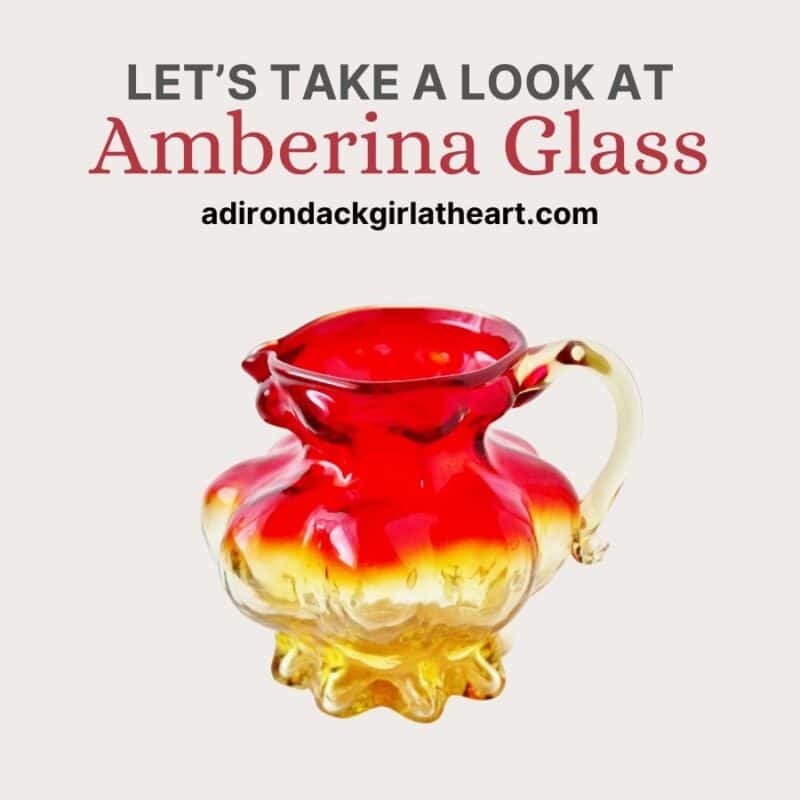
Characterized by bold red to amber/yellow gradation, Amberina glass brightens any room and fairly glows when the sun shines through it.
Amberina Crackle Glass
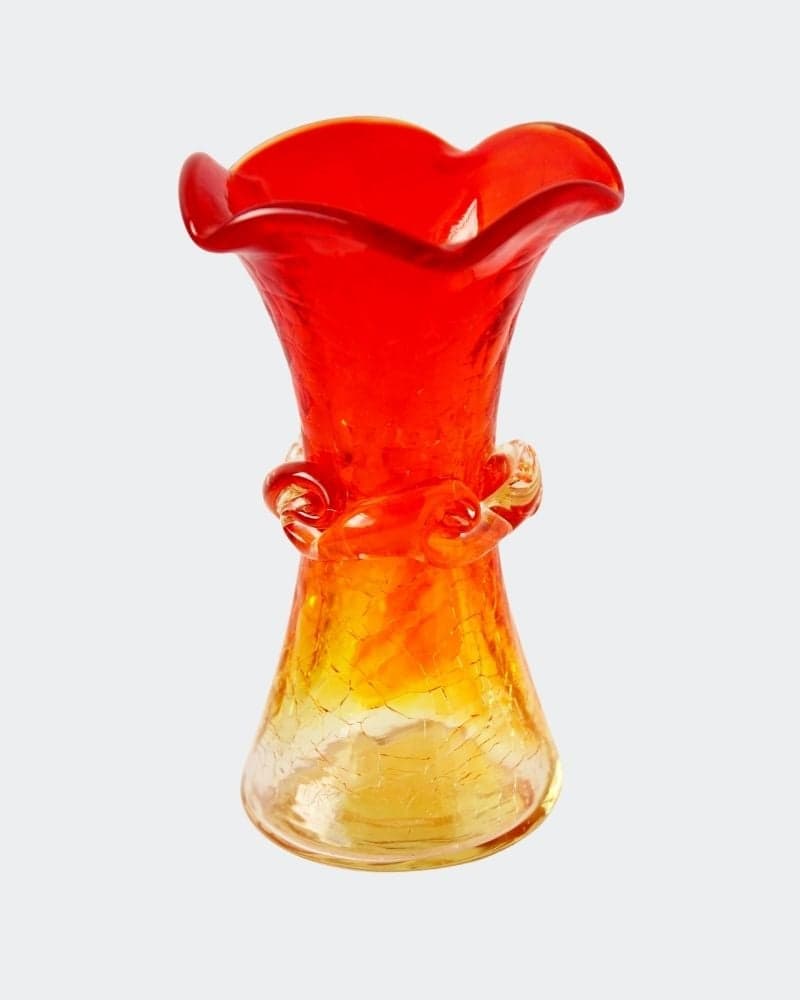
Crackle glass (like the piece you see here) comes in a rainbow of colors, including Amberina. Made throughout the 1950’s and 60’s in a rainbow of colors, it’s a popular MCM collectible. That said, the Blenko Glass Company of West Virginia continues to manufacture it today. Value of this 4″ Amberina vase: $10-12
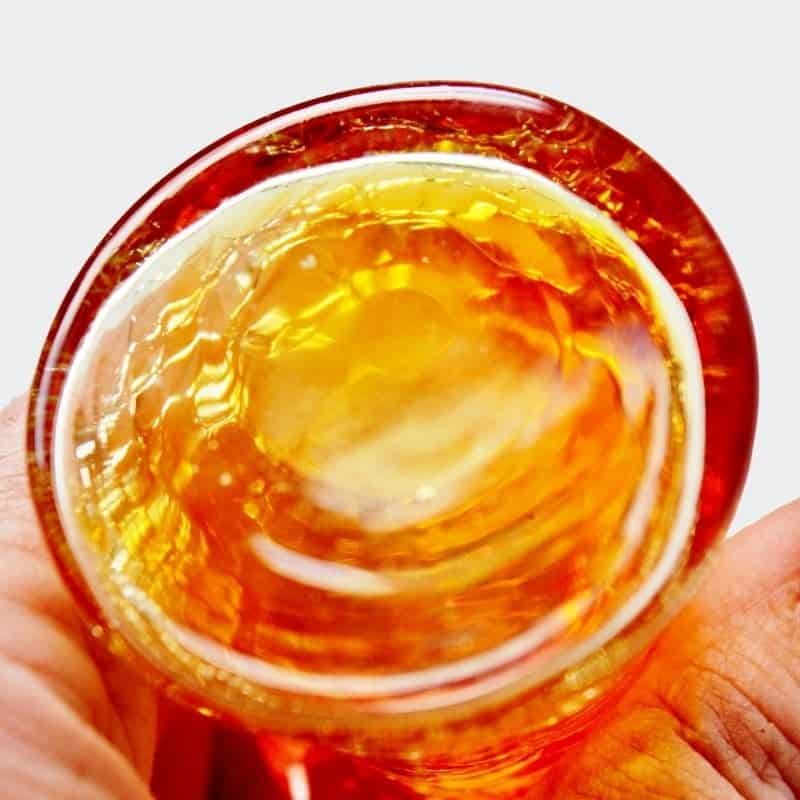
Since crackle glass is hand-blown, you might expect to see a pontil mark on the bottom. When a glass maker “breaks” a piece off of his pontil—the long metal rod that he blows the glass on–it leaves a circle of broken glass on the bottom. (See an example in my crackle glass guide.)
You do not see a pontil mark here because it has been ground down to a smooth, round indentation. This could rule out Blenko glass as a manufacturer since you will find a pontil mark on most of their pieces.
I also didn’t find this pictured in any Blenko catalogs, so another crackle glass company, like Pilgrim or Rainbow, likely manufactured it. (It’s interesting to note that in their catalogs, Blenko referred to their Amberina glass as Tangerine.)
Related:
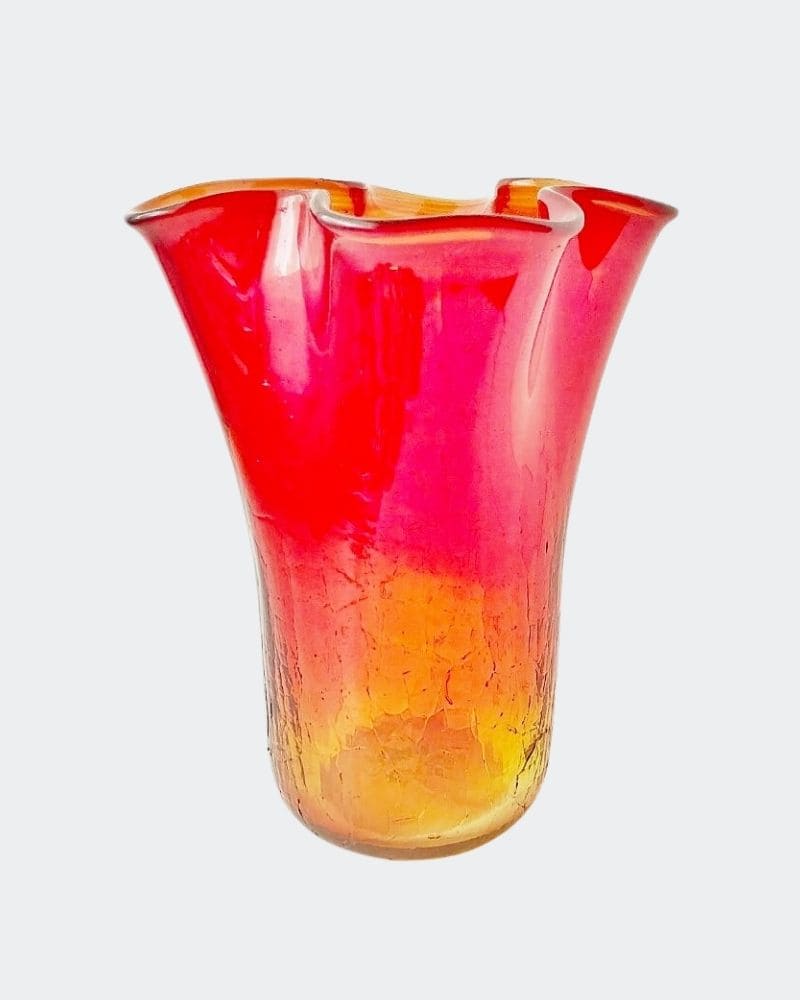
This 8″ Amerina hankie vase, also crackled, would sell for $18-25.

This lovely 6″ crackle glass vase in Amberina, with its globe-shaped base and flared top, would go for $15-18.
L.E. Smith Amberina
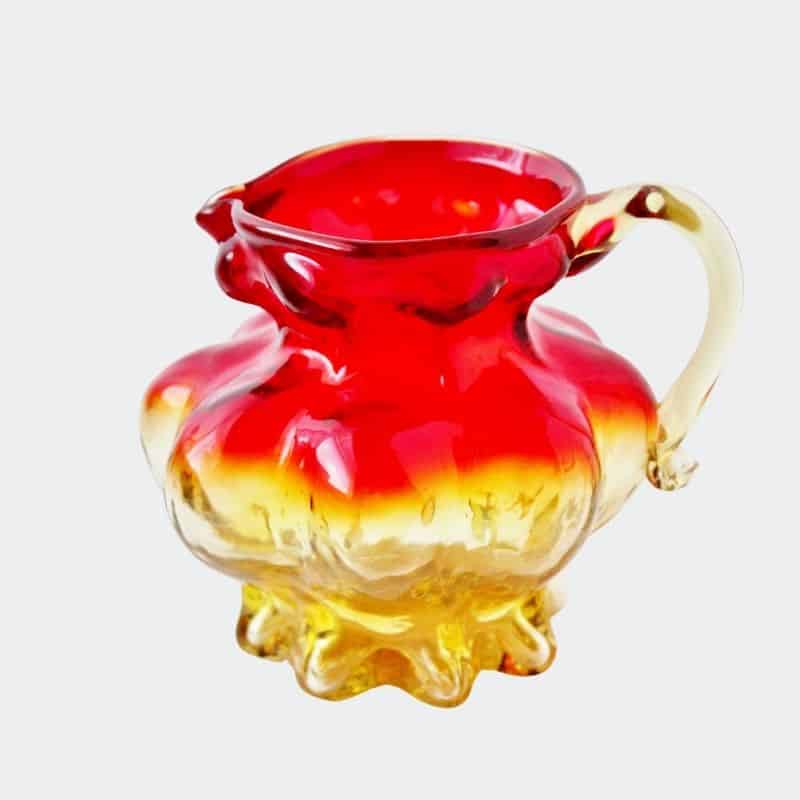
I would value this handblown piece by L.E. Smith, with it’s fancy scallopped base, bulbous body, and applied handle, at $20-25.
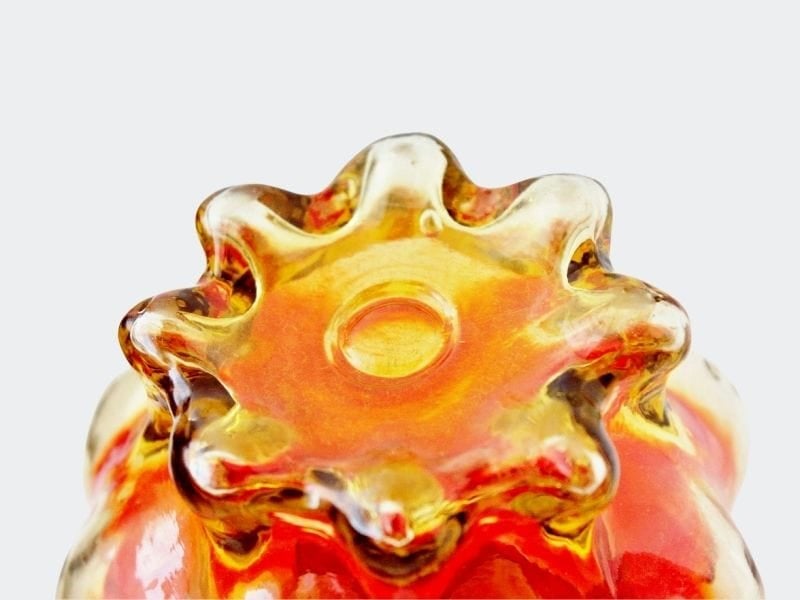
Here you see another example of a beautifully ground out pontil mark on the base of this L.E. Smith pitcher.
Imperial Glass Company Amberina
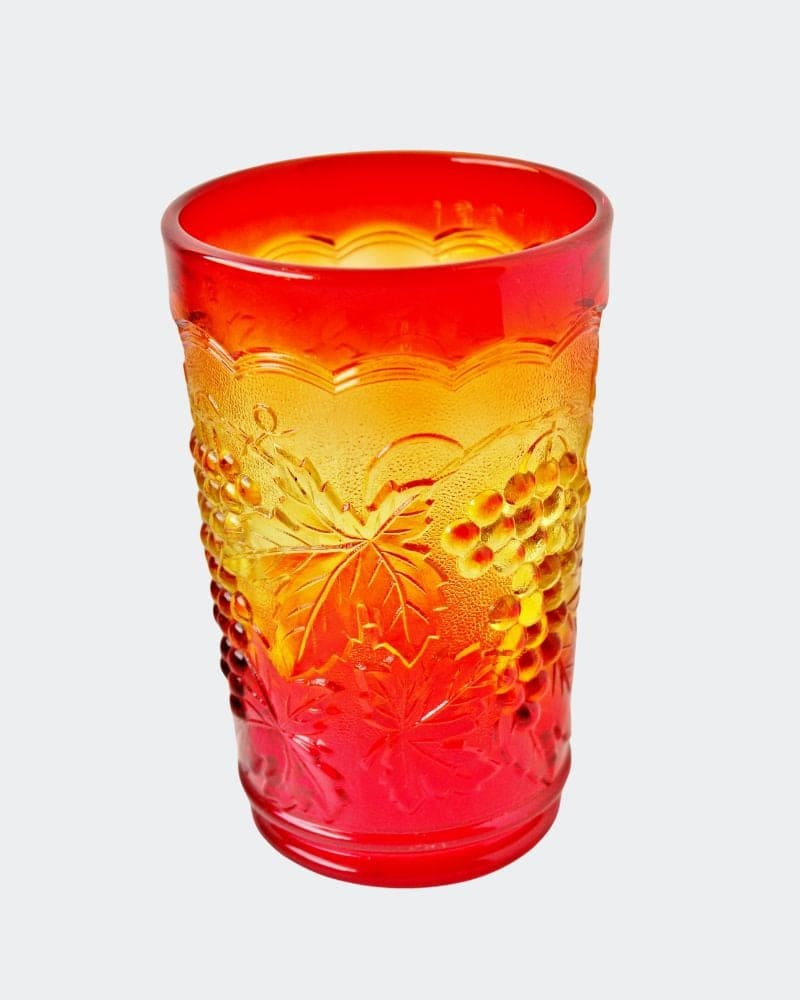
The Imperial Glass Company (1901-1984) out of Bellaire, Ohio, made its mark creating glass tableware in wildly popular patterns like Candlewick and Cape Cod.
This Grape pattern (#473) tumbler in amberina, also comes in many shades of carnival glass–marigold, blue, and green, for example. A set of four of these Amberina glasses would run about $50-60.00.
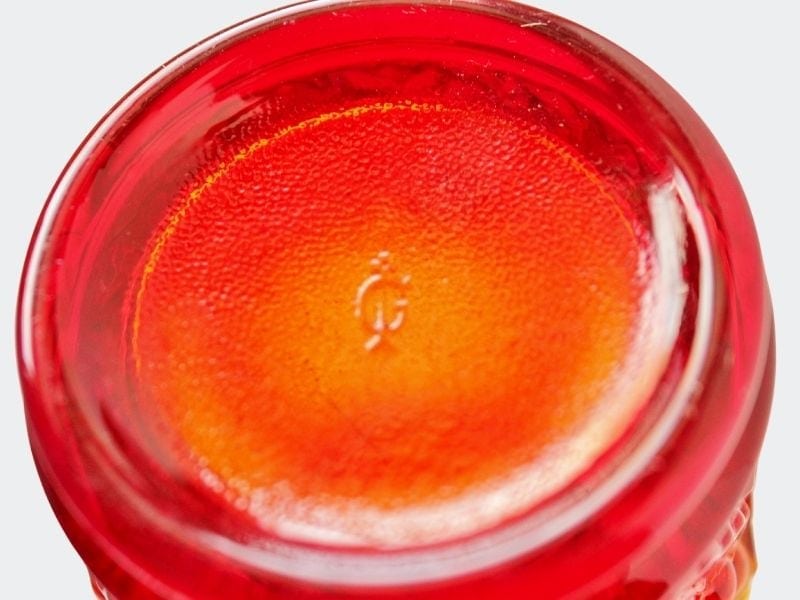
We know Imperial Glass manufactured the tumbler because of the mark on the base. They used a “G” superimposed over a stylized “I” as their mark from 1951-77.
Kanawha Amberina Toothpick Holder
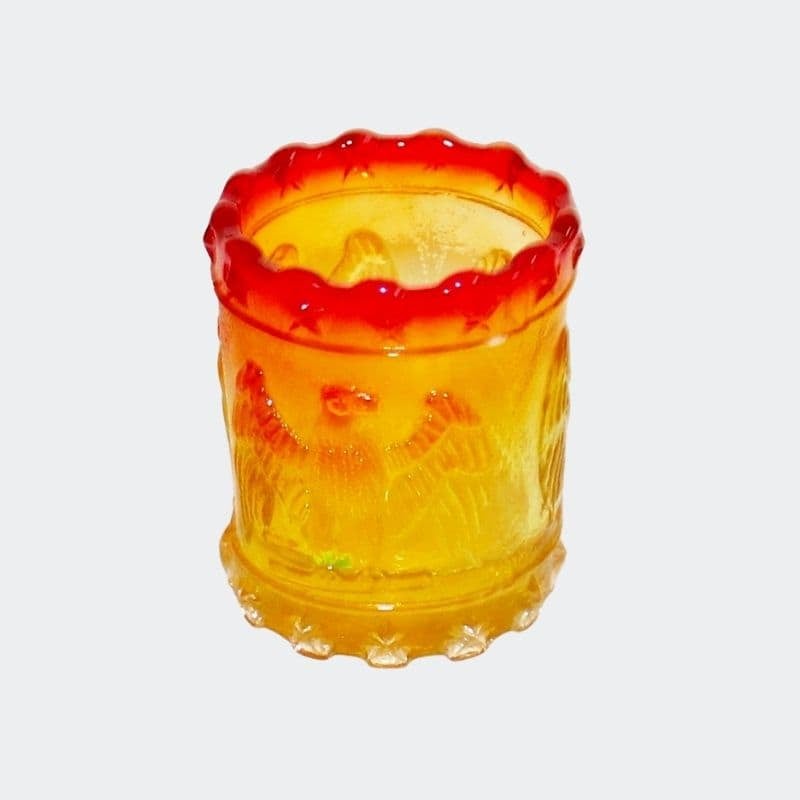
Kanawha glass (1957-88), located in West Virginia, designed this little Amerina cutie, which dates to the celebration of the American bicentennial (1976). The design on this toothpick features a series of American eagles. Value: $12-15
Related: Vintage & Antique Toothpick Guide
How Older & Newer Amberina Were/Are Manufactured
Amberina has had two heydays–an early period (1883-1900) and a late period (1950-60). During the early period, glass makers reddened the glass by adding gold to amber-colored glass.
Reheating portions of this glass created a chemical reaction with the gold and turned those heated portions from amber to red, with a pink to ruby cast. The early period pieces tend to be much more valuable than the late, in the $100-$500 range and on up. You can find examples of early period Amberina here.
A renewed interest in Amberina in the 1950’s and 60’s drove glass companies to reintroduce it to the market. By this time they had discovered a cheaper way to turn amber glass red by adding selenium and cadmium sulphide, rather than gold, to the process.
As a result, Amberina from this period has more of an orange cast than early period pieces. (Note: Amberina is still being produced by some glass companies, Fenton, for example.)
Fake Amberina
Like many other antiques and collectibles, inferior versions of Amberina were introduced into the market by companies trying to make money off of its popularity. Keep your eye out for ruby-colored glass that has been flashed on by applying and heating a thin layer of gold to the outer surface of amber glass.
This flashed on “paint” scratches and flakes quite easily (through to the clear glass below) and the gradation from red to amber is not as gradual. To learn more about Amberina, ask an antique shop owner to show you a few pieces. Weigh it in your hands, feel the surface, and hold it up to the light. Hands on is the best way to learn!
How do you feel about this orange-toned collectible?
Would you buy a piece if you saw it–yea or nay?
Thanks for stopping by–
If you enjoyed this post, subscribe today
and get a FREE copy of my eBook:
Bye for now,
I’d love it if you’d pin me!




Yes, I would buy it! Beautiful! Love the colors. Love your educational blog posts. I follow you faithfully!
My mom had a crackle glass collection of small vases, but none in orange. I can picture blue, green and maybe even purple? Who knows what happened to them! Thanks for the insight into their history and value! xo Kathleen Charm Bracelet Diva {At Home}
I would buy it, mostly because its so different . Love the colors
Diana, interesting to learn about this collectible glass, thanks for sharing it!
I would certainly buy it to resell. It’s always interesting to find out about new collectibles.Thanks for sharing the info. Now I’ll know what it is if I see it.
Very interesting read, Diana! Pretty glass!
The glass is pretty. I don’t expect it is very common. I really enjoy your posts about different collectibles.
I so appreciate your posts about glass. I have a big gap in this area. I noticed the color before I saw the crackle. Once you referred to the crackle, I paused and studied it. How lovely. But anything orange reminds me of mid-century modern, which I’m always on the lookout for. I saw your post at Elizabeth & Co’s party.
I have not heard of or seen amberina, but it is beautiful.
Thanks for sharing with SYC.
I am glad to have stumbled upon this writing. I’ve recently come across pieces in this tone, and wanted to find out more. I am pleased to know what it is so I can more easily find other pieces of interest. Thank you!
Thanks so much for visiting and leaving a comment! Good luck building your collection and I hope to hear from you again 🙂
Just ran across and read your article. Now that I know how to identify Amberina glass I will grab it if the price is right. I’m a new collector of Vaseline and Uranium Glass, and when out of town my wife and I will stop at antique shops, yard sales, and flea markets searching for items that may want to come home with us.
I have run across both Vintage and Fake pieces of Amberina glass and never knew what I was looking at until now. Your article has significantly increased my learning curve and will now be included in our hunting endeavors. Thanks for posting this great educational read.
I’m so glad you found the post helpful Darrel. Buying antiques for business or pleasure is a constant learning process, isn’t it?? Good luck building your collection–so nice that you share the endeavor with your wife 🙂
I am so happy to have had your help in identifying my family Amberina glass water pitcher and glass set. I knew how old it was because it was my grandmothers. It was easy to go futher. Now that I know the value it will be easier to convince my daughter-in-law of its value for her home. She is a pottery barn type designer.
I’m so glad my article was helpful Barbara! I hope your daughter-in-law loves it 🙂
Hi Diana! I have just found out about this glass. It’s very stunning! I found a piece today and I’m not sure if it’s real or not…It’s red on top and yellow on the bottom it’s a flower shaped glass bowl. It has seams on both sides , so I’m not sure if the seams has anything to do with it being real Amberina glass or not. Can you please help in lighten me? Thanks !
It IS very pretty glass, isn’t it? There are numerous guidebooks on various kinds of glass that could help you identify your piece. Check your library and/or bookstore. There are also number FB groups for glass lovers–some general, some specific. You may be able to find one on amberina. Lastly, you could bring your piece to an antique shop or auction house and ask them for help identifying it. Good luck Deborah!
I sold an Amberina oil lamp earlier this year on ebay for $81.00. It was very pretty.
Thank you for your informative articles. I follow you on YouTube and have seen all 117 videos. I look forward to each new one!
Wow that’s truly amazing–all 117 videos?? I think you’re my most avid fan Julie! So glad you enjoy them 🙂 Congrats on selling your amberina lamp for such a great price–woo woo!
Don’t believe I had missed this article. Now I know a lot more about amberina. I buy it when I find it reasonably to resell–but that isn’t very often!
I’m so glad you enjoyed the article Kathy! I agree, amberina’s not that easy to come by-